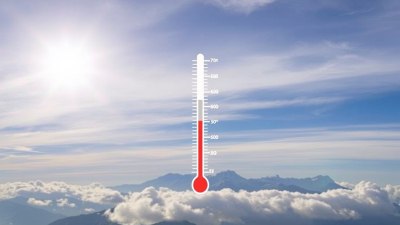How Your Mood Syncs With the Forecast Without You Knowing
Discover how weather patterns influence your mood and behavior subconsciously in surprising ways.

Weather and mood have long been thought to share a mysterious connection, with common sayings like "feeling under the weather" revealing a deep-rooted cultural recognition of this link. But how exactly does the forecast influence our emotions, often without our explicit awareness? Scientists and psychologists have studied the interplay between atmospheric conditions and human psychology, uncovering a complex relationship that affects us at multiple levels — from daily moods to broader mental health patterns.
This article explores the subtle ways your emotional state syncs with the weather forecast, revealing the mechanisms behind this phenomenon and offering insights into how you might harness this knowledge for improved well-being.
The Psychological Impact of Weather
It's no secret that certain weather conditions can sway our feelings. Sunshine often lifts spirits, while gray skies and rain may bring about reflective or melancholic moods. But the influence reaches beyond these simple assumptions. Exposure to natural light, for instance, has a direct effect on the production of serotonin and melatonin — neurotransmitters that regulate mood and sleep.
Research has shown that sunlight plays a critical role in maintaining circadian rhythms and boosting serotonin levels, which is why bright days often coincide with elevated moods. Conversely, when sunlight diminishes due to overcast skies or shorter days during winter months, some individuals may experience symptoms of Seasonal Affective Disorder (SAD), a form of depression linked specifically to changes in seasons.
Chronic Weather Patterns and Emotional Well-Being
While short-term weather fluctuations can cause immediate shifts in mood, long-term weather patterns also contribute to mental health outcomes. Populations living in regions with frequent sunshine tend to report higher overall life satisfaction and lower rates of depression compared to those in consistently gloomy or rainy climates.
However, the story isn't entirely straightforward. Heat extremes, for instance, can increase irritability and aggression, suggesting that not all bright or warm conditions guarantee positive moods. Recent studies have also found connections between changes in barometric pressure and anxiety symptoms, indicating that even subtle meteorological variables affect neurochemical balances.
Subconscious Recognition of Weather Forecasts
One fascinating aspect of mood-weather interplay is how people subconsciously anticipate changes based on weather forecasts, even when they don't consciously register them. This phenomenon means that before a storm or cold front arrives, individuals might already experience mood shifts influenced by their implicit awareness of these changes.
Scientists attribute this anticipation to the brain's ability to process environmental cues below the level of conscious awareness. For example, subtle changes in daylight, humidity, or atmospheric pressure can signal an approaching weather event, triggering physiological responses. These responses affect hormones like cortisol, which modulate stress and emotional reactions.
The Role of Barometric Pressure
Barometric pressure, often overlooked in everyday weather discussions, plays a significant role in mood regulation. When pressure drops ahead of storms, many people report headaches, lethargy, or heightened anxiety — symptoms believed to arise from changes in oxygen levels and brain chemistry. Conversely, high-pressure systems typically correlate with clear skies and a general sense of well-being.
Research measuring the effect of barometric changes on serotonin activity supports the notion that these fluctuations influence mood stability. This link explains why some might feel inexplicably tired or down just before bad weather, even if they have no direct knowledge of the forecast.
Temperature’s Multifaceted Effects
Temperature has an intricate relationship with emotion beyond simple comfort. Mild temperatures generally boost social interaction and outdoor activities, fostering happiness and community connection. However, extremes on either end—heat waves or cold spells—pose physiological challenges that can impair mental clarity and increase stress.
Heat, in particular, can lead to increased aggression and decreased patience. Studies have correlated higher crime rates with hot weather, suggesting that elevated temperatures can heighten irritability. Cold weather, while often promoting quieter, more introspective moods, can also trigger seasonal mood declines in certain individuals, reflecting a delicate balance in how temperature influences mental health.
Humidity and Air Quality Considerations
Humidity affects mood less obviously than temperature or sunlight, but its impact is no less real. High humidity can cause discomfort, fatigue, and difficulty concentrating, all of which contribute to feelings of irritability or sluggishness. In contrast, very low humidity may dry out airways, leading to physical discomfort that impacts emotional well-being.
Air quality, closely linked with weather conditions, also interacts with mood. Poor air quality during stagnant weather or pollution-heavy days can worsen symptoms of anxiety and depression. Even subtle variations in pollen counts, influenced by weather, can affect individuals prone to allergies, indirectly shaping mood through physical discomfort.
Seasonal Rhythms and Mood Synchronization
Human beings evolved with the seasons, and many aspects of our biology remain attuned to seasonal rhythms. Changes in daylight length serve as a powerful zeitgeber—a cue that sets our internal clocks. These shifts regulate hormones and neurotransmitters that control energy levels, appetite, and emotional responses.
During spring and summer, longer days encourage physical activity and social engagement, both of which improve mood. In autumn and winter, shortened daylight hours can lead to decreased activity and lower serotonin production, contributing to feelings of melancholy or sluggishness. This seasonal mood synchronization has been documented across cultures and geographies, emphasizing its fundamental role in human psychology.
Weather-Driven Behavioral Changes
Our behaviors subtly adjust based on weather conditions, often without conscious realization, which further reinforces mood-weather coupling. Good weather frequently promotes outdoor activities, exercise, and socialization, all beneficial for mental health. Conversely, dismal weather encourages indoor solitude, which can either allow for restful recuperation or exacerbate feelings of isolation, depending on individual circumstances.
Understanding these patterns helps explain why mood fluctuations accompany specific forecasts. For instance, anticipation of a rainy weekend might subconsciously reduce plans for social gatherings, lowering excitement levels in advance. Meanwhile, upcoming sunny days might enhance optimism days before arrival.
Technology’s Influence on Weather-Mood Awareness
The rise of smartphones and ubiquitous weather apps means that people are constantly exposed to forecast information. Surprising research suggests that this easy access can intensify mood responses to weather expectations, sometimes heightening anxiety or disappointment when forecasts predict unfavorable conditions.
While traditional weather cues like feeling the sun or wind remain powerful, modern technology adds a new layer to how weather perceptions shape emotional states. People might check forecasts multiple times daily, which can create a feedback loop between weather expectations and mood swings.
Strategies to Manage Mood Variability Linked to Weather
Recognizing how weather influences mood is the first step toward managing its emotional effects. Establishing routines regardless of external meteorological conditions helps stabilize mood fluctuations. Using light therapy lamps during darker months compensates for reduced natural light, alleviating symptoms of Seasonal Affective Disorder.
Maintaining physical activity even during poor weather, such as indoor exercises, supports consistent serotonin production. Additionally, mindfulness and cognitive behavioral techniques can help individuals reframe negative anticipations tied to weather forecasts, reducing subconscious mood dips.
Monitoring one's own emotional patterns in relation to weather can create awareness, allowing for proactive mood management. For instance, scheduling social interactions strategically or planning enjoyable indoor activities during forecasted gloomy days enhances emotional resilience.
The Science Behind Weather and Mood Patterns
Neuroscientific research delves deeper into how weather affects brain function and hormonal activity. Changes in sunlight exposure directly influence the hypothalamus, which regulates circadian rhythms and hormone secretion. Cortisol, the stress hormone, fluctuates with environmental stimuli like temperature and pressure, mediating feelings of anxiety or calm.
Moreover, some theorists propose that evolutionary pressures made humans sensitive to weather changes as an adaptive survival mechanism, promoting caution during storms or encouraging activity during favorable conditions. The brain’s limbic system, responsible for emotions, is intricately connected to sensory inputs detecting environmental variables.
Individual Differences in Weather Sensitivity
Not everyone experiences mood shifts in the same ways or intensity. Genetic predispositions, personality traits, and preexisting mental health conditions influence an individual's sensitivity to weather. Some people are weather reporters of sorts, acutely aware of atmospheric changes and their own mood reactions, while others remain largely unaffected.
For example, individuals with bipolar disorder or anxiety disorders often exhibit heightened responses to weather fluctuations. Recognizing personal weather sensitivity can guide tailored coping strategies, such as adjusting medication or engaging in particular therapeutic techniques during vulnerable periods.
Debunking Myths Surrounding Weather and Mood
While the mood-weather link is real, it’s important to avoid oversimplifications or fatalistic beliefs. Not every rainy day guarantees sadness, nor does sunshine automatically produce happiness. Emotions are multi-faceted, influenced by myriad social, psychological, and physical factors.
Additionally, cultural attitudes shape interpretations of weather effects, with some societies viewing rain positively as cleansing or renewing, which can frame mood differently. Understanding these nuances prevents misattributions and encourages a balanced perspective on the weather's role in emotional life.
Practical Applications and Future Research
Our growing understanding of the weather-mood connection informs fields such as urban planning, mental health care, and even workplace design. Incorporating natural light in architecture, designing parks that encourage outdoor activity, and timing interventions around seasonal shifts are practical outcomes of this research.
Future studies aim to further disentangle the complex biological pathways linking weather with brain chemistry, enhancing predictive models and personalized approaches. Innovations like wearable sensors tracking physiological responses to environmental changes promise to deepen insights into this dynamic relationship.
Ultimately, acknowledging how your mood syncs with the forecast allows for greater self-awareness and control over emotional well-being, making weather less a passive force and more a navigable influence.











